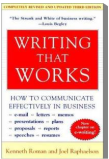
How to communicate effectively in business

| Book of the Month | ||
 |
Writing that Works How to communicate effectively in business |  |
Publisher: Quill
Authors: Kenneth Roman & Joel Raphaelson
$13.00
ISBN 0-06-095643-7
The introduction to Chapter two of this book reminds us that to stop the Tower of Babel from being built, God prevented people from understanding each other. Lack of communication stopped the project imediately. To prevent lack of clear communication from interfering with your business life, the authors have produced this little book. Its purpose is clearly stated in the introduction - 'to help those millions of nonprofessional writers who must use the written word to get results'. This book is particularly useful for those for whom English is not their first language, but who must write their business communications in English. However, it is assumed that the business communications are to those in an Anglo-Saxon culture, where clarity and directness are important. The debt reminder on p.83 (for example) might be offensively blunt in an Asian culture, and some Europeans might find the writing style inappropriately informal. However, it is precisely because different cultures have different writing styles that this book is useful for non-English speakers writing to people in Anglo-Saxon cultures.
The authors follow their own advice. This book is clear, direct and brief. There are 189 pages overall, and only a short bibliography at the end. This third edition has been updated to cover electronic communications and the increased need for political correctness. It explains for example why the word 'gyp' (meaning 'to cheat') is offensive and should not be used. The book also explains how emails are different from standard letters. For a start, emails are likely to be read by someone who is also doing many other things, so even more than other letters, emails need to get right to the point. Other chapters deal things which every business person does routinely; letters, memos, presentations, reports and proposals. There are also sections on preparing notes for public speaking and on resumes (the latter being CVs in British English). The section on resumes is typical of the approach in this book. It tells what should go into a job application, and how this should be presented. So readers are advised not just about the language, but also the type and colour of paper a resume should be written on. The text also deals with cultural questions such as whether it is a good idea to contact the company informally before sending a written job application.
Who is this book for? This book is about effective writing. It deals not just with language and using language correctly, but also how to use that language in business communications - especially with North Americans. Anyone who has business dealings with North Americans but is unfamiliar with their culture will be pleased that this book goes beyond language to also describe the best way to present written material. Whether you are writing a report, asking for funds, or looking for a job, this book not only help you to write what you need to communicate, but do it in the best way possible.
Verdict: As much about culture as about language usage
Assessment 9/10